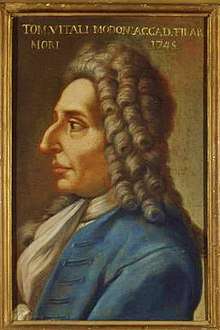Tomaso Antonio Vitali
Tomaso Antonio Vitali (March 7, 1663 – May 9, 1745) was an Italian composer and violinist from Bologna, the eldest son of Giovanni Battista Vitali.[1] He is known mainly for a chaconne in G minor for violin and continuo, which was published from a manuscript in the Sächsische Landesbibliothek in Dresden in Die Hoch Schule des Violinspiels (1867) edited by German violinist Ferdinand David.[2] That work's wide-ranging modulations into distant keys have raised speculation that it could not be a genuine baroque work.
Tomaso Antonio Vitali | |
|---|---|
 | |
| Born | Tomaso Antonio Vitali March 7, 1663 |
| Died | May 9, 1745 (aged 82) Modena, Italy |
| Nationality | Italian |
| Occupation | Composer and violinist |
Biography
Vitali studied composition in Modena with Antonio Maria Pacchioni, and was employed at the Este court orchestra from 1675 to 1742. He was a teacher, whose pupils included Evaristo Felice dall'Abaco, Jean Baptiste Senaillé, Girolamo Nicolò Laurenti and Luca Antonio Predieri.[1]
Authentic works by Vitali include a set of trio sonatas published as his opus numbers 1 and 2 (1693), sonatas da camera (chamber sonatas), and violin sonatas (including his opus 6) among other works. Among those that have been recorded include all of the op. 1 (on Naxos 8.570182), three of the violin sonatas (on the Swiss label Gallo), and some of the sonatas from the opp. 2 and 4 sets (opus 4, no. 12 on Classica CL 101 from Finland.)
He died at Modena.
The chaconne
A chaconne is a musical form used as a vehicle for variation on a repeated short harmonic progression over a ground bass. The Chaconne was marked by the copyist, at the time of transcription, in the upper margin of the first page of the Dresden manuscript as "Parte del Tomaso Vitalino" (Tomaso Vitalino's part),[3] who may or may not be Vitali.[4] One striking feature of the "Vitali" Chaconne's style is the way it wildly changes key, reaching the far-flung territories of B-flat minor and E-flat minor, modulations uncharacteristic of the Baroque era, as change of key signature became typical only in Romanticism. The manuscript, Sächsische Landesbibliothek Dresden, Mus. 2037/R/1, has more recently been identified as being in the hand of Jacob Lindner, a known copyist who was working at the Dresden Hofkapelle between 1710 and 1730, which lends credit to its authenticity.[5] Despite musicological doubts, the piece has been ever popular amongst violinists. For example, Jascha Heifetz chose it, in a "very much arranged and altered version", with organ accompaniment, to open his New York debut in Queen's Hall on 5 May 1920.[6] Arrangements of it exist for violin and piano by Ferdinand David and by Léopold Charlier, for violin and organ, for violin and orchestra by Ottorino Respighi, and there are transcriptions of it for viola and piano by Friedrich Hermann (1828-1907) and by Alan Arnold (contemporary American violist and music publisher, owner of "Viola World Publications") and for cello and piano by Luigi Silva.
References
- Suess 2001.
- Chaconne for violin & continuo in G minor, as reviewed by Michael Jameson on Allmusic
- Reich 1970, 40,
- Andrew Manze. "Angels & devils of the violin" Archived 2008-12-05 at the Wayback Machine
- Reich 1970, 39; "Baroque Virtuoso" Archived 2015-10-08 at the Wayback Machine
- Anon. 1920. "A New Violinist: Jascha Heifetz at Queen's Hall". The New York Times (Thursday, 6 May): p. 14.
Sources
- Reich, Wolfgang. 1970. "Sein oder nicht sein? Nochmals zur 'Chaconne von Vitali'". Die Musikforschung 23, no. 1 (January–March): 39–41.
- Suess, John G. 2001. "Vitali: (2) Tomaso Antonio Vitali". The New Grove Dictionary of Music and Musicians, second edition, edited by Stanley Sadie and John Tyrrell. London: Macmillan Publishers.
Further reading
- Newman, William S. 1972. The Sonata in the Baroque Era, third edition. The Norton Library. New York: W. W. Norton & Company.
- Reich, Wolfgang. 1965. "Die Chaconne g-Moll: von Vitali?". Beiträge zur Musikwissenschaft 7:149–52.
Selected discography
- Tomaso Antonio Vitali: Twelve Trio Sonatas Op. 1. Performed by Luigi Cozzolino (violin), Luca Giardini (violin), Bettina Hoffmann (cello), Gianluca Lastraioli (theorbo and guitar), Andrea Perugi (organ and harpsichord). Released in 2006. Naxos 8.570182